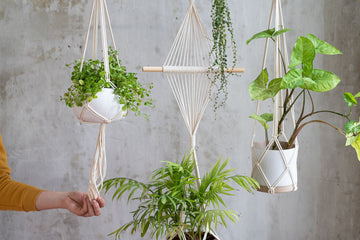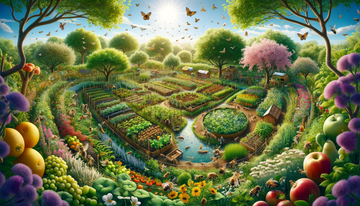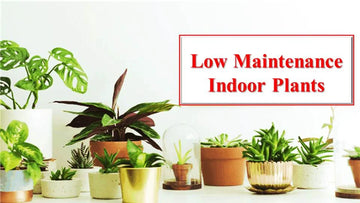Top 10 Succulent Plants for Indoor to Brighten Up Your Living Space
by Poonam Singh on Dec 23, 2022
Budsnblush is one top solution for Indoor succulent plants are currently very popular in the world of interior design and home decor! This is primarily due to succulents being extremely low maintenance and a plant type that is extremely difficult to kill, even for those who can't keep a plant alive. Succulents not only add style to a home or workspace, but they also help to keep the living space fresh.
Succulent plants are very appealing, but they adapt well to the Indian climate and require very little water on a daily basis. They are ideal interior plants for your home, and can be displayed in the living room or on the library study table. Another great place to hang succulents is in the kitchen.

What are the best succulent plants for home?
Succulent plants are typically fleshy & bulbous in appearance and considered as among the best indoor plant in India. The leaves are either spherical or cylindrical, with roots that are extremely close to the soil's surface. Plants have become so synonymous with home decor that many people associate succulent plant meaning with only interior design and interior.
Best indoor succulent plants available in India
We've created a list of some of the best indoor succulent plants available in India. So, if you want to go green and are looking for some great indoor succulent plants, this list is for you.
Crassula Ovata is another stunning beauty with a botanical name. The Jade plant is suitable for living and dining home décor and can be kept as a house plant. It is commonly known as the lucky plant and produces lovely white and even pink flowers on occasion.
The jade plant can grow to be 3 to 5 feet tall and does not require much water. Keep the plant in an attractive gold or white planter to add a touch of green to your urban space.
-
Zebra plant
Haworthia zebra plant is the best succulents for indoor
Zebra plants succulents thrive in medium and low light conditions, which are common in an indoor setting. However, to bring out its stunning red and orange pigments, place them in a location with as much natural light as possible, such as a south or east-facing windowsill.
Zebra plant succulent bloom / Zebra plant succulent propagation / zebra plant succulent growing long stem
-
Hens and chicks plant
Hens and chicks are succulent plants in the Sempervivum family. They are commonly known as houseleeks and thrive in both cool and hot temperatures. Hens and chicks plants get their name from their rosette shape and proclivity to produce numerous babies. A rockery or a dry, nutrient-deficient location is ideal for raising hens and chicks. Hens and chicks, sedum, and sprawling rock cress should all be included in an easy-care garden plan.
-
Earth Star Random Color Pink
Cryptanthus, also known as Earth Star, is a type of bromeliad. They grow in the lower jungle, away from direct sunlight. These lovely star-shaped plants come in a variety of colours, including pink, red, yellow, brown, and red. They are also extremely simple to maintain. Simply provide a small amount of water and keep in the shade. Every autumn, they also change colour.
About 35 species of succulents are found in the genus Lithops. Their development pattern is subterranean, and frequently the upper leaves are hardly discernible above the ground.
By blending in with the nearby rocks, these succulent plants can avoid being eaten, earning them the common names Living Stones and Stone Plants. Grow in direct, hot sunlight.
They generate vibrant, daisy-like blooms and come in a range of designs and colours.
To prevent mushy succulents and a lot of disappointment, effort should be taken to fit the particular seasonal cycle of lithops. Treat them differently than other succulents; throughout the summer, watering should cease entirely as they go into a powerful dormant state.
Combination of lithops species / Lithops, likewise called living
-
Mirror ball haworthia succulent plant
Haworthia Mirror ball has distinctive, windowed, and textured leaves. width of approximately 2 inches.
The plant you get will resemble the one in the picture. Due to seasonal variations, lighting, temperature, and other factors, the size, shape, and colour of the plant may differ from the photograph. Unless otherwise noted, all succulents are sent bare root.
Except for their flowers, haworthia resemble small aloes in general. They are well-liked plants for gardens and containers. The plants have the option of growing alone or in clumps. Their white, tiny flowers are very similar in appearance between species. Their leaves, however, vary greatly.
-
Tiger jaw succulent Plant
The common name of Tiger's Jaw is accurate. The pointed spines that border the pairs of spotted leaves resemble a fearsome tiger's teeth. Their unique leaves and slow growth pattern are a stunning complement to a succulent dish garden.
In their natural arid, rocky habitat, these South African succulents form clumps of stemless, star-shaped rosettes. They'll feel completely at home in the same hot, dry, sunny surroundings.
On plants that are a few years old, yellow, daisy-like blossoms may bloom in the fall. In the summer, they require 3 to 4 hours of direct sunlight each day in order to blossom. Your plant will receive the necessary light if you move it outside for the summer.

-
Moonstone succulent
A important alternative to your collection of plants could be the succulent Pachyphytum Oviferum, sometimes known as moonstones. This plant, which has distinctive and lovely aesthetics and can look startlingly gorgeous whether you grow them in your garden or containers, has silvery, plump leaves. If you give Pachyphytum Oviferum the proper growing circumstances, it can be a trouble-free plant, much like other succulents.
Therefore, if you are considering bringing these amazing succulents into your home, be sure to provide them with the proper soil, moisture, and light levels. Here are some instructions for caring for moonstones. Choose a location in your garden that receives year-round, direct sunlight where you may plant your Pachyphytum oviferum.
-
Bare root assorted succulent plants
Huge leaves are a sign of succulent plants. These plants are native to Mexico, Argentina, and a few European desert regions. There are more than 150 species of succulents, some of which are still undiscovered. The Christmas cactus, Kalanchoe, Aloe, Haworthia plants, String of Pearls, Senecio, and other well-known and beautiful members of this family are only a few examples.
These plants are not only adorable, but they also yield gorgeous flowers. Plants in the succulent family are incredibly simple to reproduce. Succulent plants can be grown using a variety of techniques, such as root division, stem cutting, and leaf propagation.
-
Sedum burrito succulent
The amazing succulent known as "Donkey's Tail," Sedum morganianum 'Burrito, has thick trailing stems covered with overlapping, plump, blue-green leaves. The tips of stems may bear pink or red star-shaped flowers in the summer.
It is normally grown as a houseplant but can be taken outside in the summer because it is too delicate for our environment. It adds a unique element to hanging.
Just One Thought on the Best Indoor Succulents
Succulents are a diverse and beautiful plant that is suitable for anyone, regardless of gardening experience. With their unique shapes, vibrant colours, and textured leaves, these plants can add a touch of elegance to any space with minimal care. Indoor succulents are sure to pique your interest and become a major passion for even the most seasoned gardener, whether you choose to plant a single species or create an eye-catching arrangement using multiple varieties. So, why delay? Begin exploring the various types of succulents today and see for yourself their dazzling potential!
Written by Poonam Singh
Thank you














